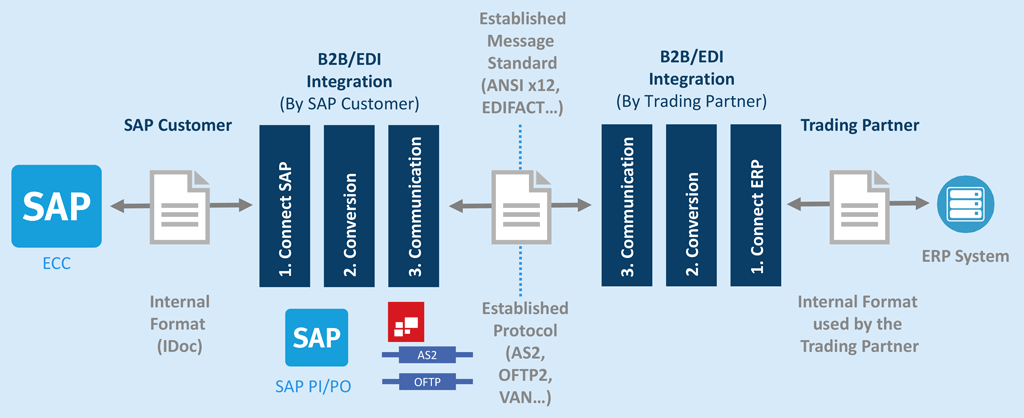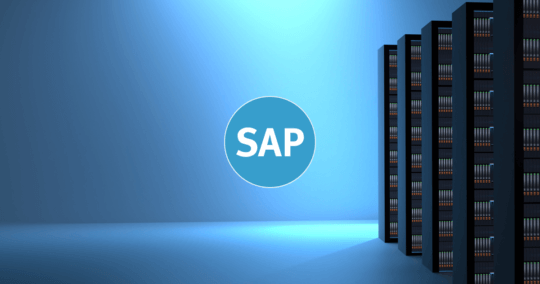Options for SAP PI EDI Adapters when migrating to S/4HANA

In 2027, SAP ECC and SAP PI systems will no longer be supported through SAP. Many companies using these legacy systems will migrate to the new SAP S/4HANA as their new ERP. But how to best replace SAP PI/PO and EDI adapter capability? This blog explains how to modernize SAP PI EDI Adapters or in a similar way the SAP PO B2B Add-on during the crossing of the bridge to SAP S/4HANA.
Typical Setup of SAP ECC and SAP PI EDI Adapters
SAP PI/PO is bound to the destiny of SAP ECC (SAP ERP Central Component) and thus SAP PI is sunset in 2027, or with extended maintenance by 2030. Details can also be found at the SAP Note 1648480 if you have a SAP JAM account. SAP PI obviously is not the long term strategic platform for integration in the SAP S/4HANA ecosystem.
Electronic Data Interchange (EDI) is typically used to connect to larger external customers and suppliers, and some SAP ECC customers had chosen in the past SAP PI EDI adapters for this purpose. The intercompany efficiency has been fine-tuned for a long time – sometimes over decades – in these EDI partnerships, which for many supply chain oriented companies has led to running hundreds of SAP PI EDI adapter trading partner connections.
SAP Process Integration (SAP PI) enables data exchange between SAP ECC and internal as well as external systems. SAP PI uses various JAVA-based routing and integration components as well as communication adapters like the SAP PI EDI Adapters by SEEBURGER or the SAP PO B2B Add-on. These allow the use of SAP PI as a framework to utilize communication protocols and data format conversions.
SAP Process Orchestration (PO) is a SAP PI extension with different license models. SAP PO provides additional ‘business process modeling and implementation’ and includes parts of SAP Business Process Management and SAP Business Rules Management.
Consider a typical setup as shown below with a SAP ECC customer using SAP PI/PO EDI Adapter from SEEBURGER or in a similar way the SAP PO B2B Add-on connecting to a Trading Partner.

SAP PI/PO connects to SAP systems such as SAP ECC. Mappings are implemented for conversions between SAP internal formats (IDoc) and EDI Message Standards (ANSI X.12, EDIFACT, VDA, and others). These mappings are created and amended using a graphical XSLT editor or by using a JAVA based application. Business logic can be added and includes routing controls for message delivery to different recipients based on information in a message.
SAP PI communication adapters leverage message transport protocols for external integration such as AS2, OFTP2, SFTP, VAN Adapters (e.g. X.400), RESTful Web Services and others.
Migrate SAP PI EDI Adapters Integration before the Core S/4HANA Project
Imagine the complexity to migrate to SAP S/4HANA and in parallel to replace the entire internal and external SAP PI EDI integration adapters connecting hundreds of Trading Partners.
A good approach is to modernize and consolidate the SAP PI EDI connections before the SAP S/4HANA migration so that the supply chain remains protected. This modularization reduces the complexity of the overall S/4HANA migration significantly.
It makes good sense to start an open-minded replacement selection process as soon as possible, as the sunset clock is ticking.
Requirements for S/4HANA Integration beyond SAP PI EDI
EDI has been well established for many years. As such, there are many specialized vendors and cloud service providers focusing on EDI only. Few have evolved to the level of a Hybrid Integration Platform (HIP). A HIP goes beyond pure EDI capability and can connect to the non-SAP world, e.g. EAI, API Integration / Management and, Managed File Transfer, E-Invoicing as well Industrial IoT options.
A true hybrid integration platform is neutral about the applications it integrates and works with open standards as much as possible. Such a ‘Swiss Knife of Integration’ protects you from an application vendor centric lock-in and keeps your options open. For evidence of neutrality and HIP capabilities look for an explicit list of connectors which provide specific integration scenarios or technologies. Connectors are often supplied with standardized integration content (configuration data, mappings etc.) which serve to minimize implementation efforts and may make use of several adapters.
Modernize and Consolidate SAP PI and EDI
When considering your migration strategy, you should seek a state of the art EDI capability (as a software solution or an EDI Cloud Service) with a proven track record in business critical areas such as rapid on-boarding, off-the-shelf partner profiles with a repository for mappings and connections as well as a standard solution for the typical supply chain oriented industries.
During the migration to a modern EDI solution or EDI Cloud Service, it is our recommendation is to reduce the number of unique 1:1 SAP IDoc EDI mappings to the minimum through canonical (indirect) EDI mappings. Indirect mappings boost your scalability by connecting a very large number of EDI trading partners quickly. They also work with more than one ERP system with ease, either during the SAP S/4HANA migration or longer term if you use several ERP systems from different vendors. Read more on the details in our blog on Migrate to SAP S/4HANA keeping the B2B/EDI Integration running.
Allow yourselves to move to APIs at your own pace. If you procure a true Hybrid Integration Platform (HIP) with solid B2B/EDI integration capability, you can protect your supply chain and have the flexibility to gradually add API integration and API management as the business requires it.
Learn how to
Integrate SAP S/4HANA and SAP Cloud Applications using BIS 6.7 in our Webcast On-Demand.
All of the above factors will help reduce your cost due to less effort required for creation, maintenance and testing of EDI mappings and connections (as well as having integration synergies).
Consider engaging with an experienced HIP integration specialist like SEEBURGER to address the challenges that you will endure during your S/4HANA migration journey.
Be sure to check your short list of providers for references showing they can do the heavy lifting. And then challenge them with a POC!
Flexible Operation for EDI
Keep your deployment options open for EDI. A switch between an on-premises, full service or iPaaS cloud deployment model should be no problem. A provider should be certified in line with standards like ISO, ISAE, TISAX and provide industry-leading Service Level Availability (SLA) commitments when you choose the cloud option.
Thank you for your message
We appreciate your interest in SEEBURGER
Get in contact with us:
Please enter details about your project in the message section so we can direct your inquiry to the right consultant.
Written by: Frank Stegmueller
Frank Stegmüller is one of the two corporate information security officers at SEEBURGER and has been with the company since 2008. He has over 25 years of experience in service, support and information security for Enterprise Application Integration, EDI, B2B, MFT, API, ITSM and digital transformation - both on in-house systems and from the cloud. He is involved in the ISO/IEC 27001, ISAE 3402 (SOC 1) Type 2 and TISAX certification for SEEBURGER Cloud Services and knows all about the intricacies of compliant data centre operations in international environments.





